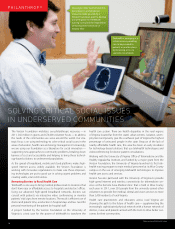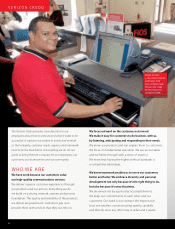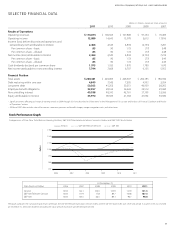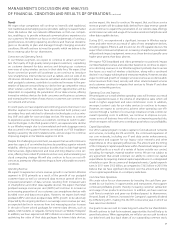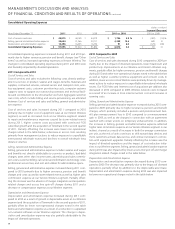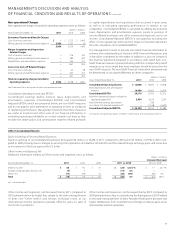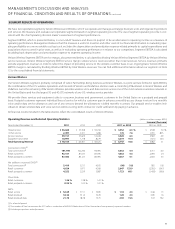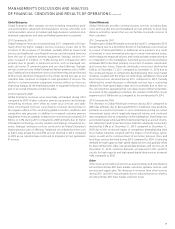Verizon Wireless 2011 Annual Report Download - page 29
Download and view the complete annual report
Please find page 29 of the 2011 Verizon Wireless annual report below. You can navigate through the pages in the report by either clicking on the pages listed below, or by using the keyword search tool below to find specific information within the annual report.Trends
We expect that competition will continue to intensify with traditional,
non-traditional and emerging service providers seeking increased market
share. We believe that our networks differentiate us from our competi-
tors, enabling us to provide enhanced communications experiences to
our customers. We believe our focus on the fundamentals of running a
good business, including operating excellence and financial discipline,
gives us the ability to plan and manage through changing economic
conditions. We will continue to invest for growth, which we believe is the
key to creating value for our shareowners.
Connection and Operating Trends
In our Wireless segment, we expect to continue to attract and main-
tain the loyalty of high-quality retail postpaid customers, capitalizing
on customer demand for data services and bringing our customers
new ways of using wireless services in their daily lives. We expect that
future connection growth will accelerate as we continue to introduce
new smartphones, internet devices such as tablets, and our suite of 4G
LTE devices. We believe these devices will attract and retain higher value
retail postpaid customers, contribute to continued increases in the pen-
etration of data services and keep our device line-up competitive versus
other wireless carriers. We expect future growth opportunities will be
dependent on expanding the penetration of our data services, offering
innovative wireless devices for both consumer and business customers
and increasing the number of ways that our customers can connect with
our network and services.
In recent years, we have experienced continuing access line losses in our
Wireline segment as customers have disconnected both primary and
secondary lines and switched to alternative technologies such as wire-
less, VoIP and cable for voice and data services. We expect to continue
to experience access line losses as customers continue to switch to alter-
nate technologies. In the third quarter of 2011, we experienced a decline
in our Wireline margin due to storm-related and work stoppage events
thatoccurredinthequarter.However,wereducedourFiOSinstallation
backlog caused by the storm-related events, and we expect to continue
improving margins in the Wireline segment in 2012.
Despite this challenging environment, we expect that we will continue to
grow key aspects of our wireline business by providing superior network
reliability, offering innovative product bundles that include high-speed
Internet access, digital television and local and long distance voice ser-
vices, offering more robust IP products and services, and accelerating our
cloud computing strategy. We will also continue to focus on cost effi-
ciencies to attempt to offset adverse impacts from unfavorable economic
conditions.
Operating Revenue
We expect to experience service revenue growth in our Verizon Wireless
segment in 2012 primarily as a result of the growth of our postpaid
customer base as well as continued data revenue growth driven by
increased penetration of data services resulting from increased sales
of smartphones and other data-capable devices. We expect that retail
postpaidaveragerevenueperuser(ARPU)willcontinuetoincreaseas
an increasing proportion of our customers use smartphone devices with
bundled voice and data service plans. However, we expect both retail
postpaidARPUandretailpostpaiddataARPUgrowthtobeadversely
impacted by the ongoing declines in our average voice revenue per user,
an expected decline in revenues from text messaging and an increase
in the sale of lower priced packages for internet data devices, such as
tablets,USBmodemsorJetpacks,formerlyknownas“MobileHotspots.”
Inaddition,wehaveexperiencedARPUdilutionasaresultofcustomers
optimizing the value of their data packages for internet data devices,
and we expect this trend to continue. We expect that our future service
revenue growth will be substantially derived from data revenue growth
as we continue to expand the penetration of our wireless data offerings
and increase our sales and usage of innovative wireless smartphones and
other data-capable devices.
During 2011, we experienced a significant increase in Wireless equip-
ment and other revenue as a result of sales of new smartphone devices,
includingApple’siPhone4and4Sandour4GLTE-capabledevices.We
expect that continued emphasis on increasing smartphone penetration
will positively impact equipment revenue as these devices typically carry
higher price points than basic phones.
WeexpectFiOSbroadbandandvideopenetrationtopositivelyimpact
ourMassMarketsrevenueandsubscriberbasebuttocontinuetoexperi-
ence declining revenues in our Wireline segment primarily due to access
line losses as a result of wireless substitution, along with a continued
decline in our legacy wholesale and enterprise markets. However, we also
expect continued growth of strategic services revenue as we derive addi-
tional revenues from cloud, security and other solutions-based services
and customers continue to migrate their services to Private IP and other
strategic networking services.
Operating Costs and Expenses
We anticipate our overall wireless operating costs will increase as a result
of the expected increase in the volume of smartphone sales, which will
result in higher equipment and sales commission costs. In addition,
we expect content costs for our video services to continue to increase.
However, we expect to continue to achieve other operating cost effi-
ciencies through a number of cost savings initiatives to help control our
overall operating costs. In addition, we continue to improve our pro-
cesses across all business lines with a focus on improving productivity,
which we expect will continue to contribute positively to our profitability.
Capital Expenditures
Our 2012 capital program includes capital to fund advanced networks
andservices,including4GLTEandFiOS,thecontinuedexpansionof
our core networks, including our IP and data center enhancements,
maintenance and support for our legacy voice networks and other
expenditures to drive operating efficiencies. The amount and the timing
oftheCompany’scapitalexpenditureswithinthesebroadcategoriescan
vary significantly as a result of a variety of factors outside our control,
including, for example, material weather events. We are not subject to
any agreement that would constrain our ability to control our capital
expenditures by requiring material capital expenditures on a designated
schedule or upon the occurrence of designated events. Capital expendi-
tures in 2011 were $16.2 billion, as compared to $16.5 billion in 2010. We
believe that we have significant discretion over the amount and timing
of our capital expenditures on a company-wide basis.
Cash Flow from Operations
We create value for our shareowners by investing the cash flows gen-
erated by our business in opportunities and transactions that support
continued profitable growth, thereby increasing customer satisfaction
and usage of our products and services. In addition, we have used our
cash flows to maintain and grow our dividend payout to shareowners.
Verizon’sBoardofDirectorsincreasedtheCompany’squarterlydividend
by 2.6% during 2011, making this the fifth consecutive year in which we
have raised our dividend.
Our goal is to use our cash to create long-term value for our shareholders.
We will continue to look for investment opportunities that will help us to
grow the business. When appropriate, we will also use our cash to reduce
our debt levels and buy back shares of our outstanding common stock,
27
ManagEMEnt’s discussiOn and analYsis
OF Financial cOnditiOn and REsults OF OPERatiOns continued



